Market Positioning – Definition, Types, Benefits, Examples & How-to
Imagine you want to be, let’s say, a detergent manufacturer, and there are thousands of other detergents in the market. Why do you think customers will buy your detergent from a cluster of “million options”?
However, if your detergent has unique features that can give your customers unique benefits, then that is a different story. People don’t want to buy a product that claims to do “everything.” Instead, they want a better solution that can tackle at least “something.” You just need to show them that your detergent can specifically do “this.”
To cut it short, you need to position your product or service uniquely. In marketing terms, this is called market positioning. Why is market positioning important, and what are your options regarding market positioning? Let’s find out.
Table of Contents

What Is Market Positioning?
Market positioning, in simple words, is a marketing strategy that focuses on creating a unique image or perception of a brand, product, or service in the customer’s mind. A business can create that unique image by any means.
For instance, the four Ps of marketing (promotion, product, price, and place) are important factors in market positioning. The more a business focuses on these 4 Ps, the will better will be its positioning in the market. Still not getting a clear picture of market positioning? Here are some examples for basic understanding:
- A shoemaker specializes in making formal shoes for highly sophisticated or formal events.
- A fast-food franchise that makes unique grilled beef burgers.
- A car manufacturing company specializes in manufacturing luxury cars with unparalleled features.
So, what was the basic theme in these examples? The sellers in these examples are focusing on a specific niche rather than catering to a general audience.
Types Of Market Positioning
Different businesses use different techniques for market positioning. However, here some of the most common types of positioning in the market.
Quality of A Product or Service
Amidst the fearsome price wars, many brands strive hard to provide quality. Yes, when you please your customer with unparalleled quality, price becomes a less-concerned issue.
Example. Chipotle has quickly gathered immense fame and climbed to the 14 th spot in the list of top 50 fast-food franchises in the USA (ranking from QSR magazine). This quality-oriented brand has already captured a significant market share and causing trouble for “big boys.”
Innovation and Uniqueness
Many brands focus on providing innovation and uniqueness. If you can bring something new and fascinating, you can charge higher prices and people will pay for it happily.
Example. What would be a better example of innovation than Apple? The electronics industry’s juggernaut has captured a massive global market just because of its mind-blowing and surreal innovations.
Price of A Product or Service
When a brand is not enriched with innovation or superior quality, then pricing is an excellent option to challenge your competitors. Whether you accept or not, price is still one of the most critical factors that affect many consumers’ purchase decision.
Example. Dollar Shave Club has proved to be a nightmare for Gillette because they offer the cheapest razor cartridge refilling (20 cents) while Gillette was doing it for $2-$5. Due to this massive difference, Gillette has seen a decreasing market share.
Product Differentiation
Similar to innovation, product differentiation is another excellent marketing strategy to take the lead. A different product or service can easily kill the competition.
Example. Tesla has revolutionized the automobile industry with its electronic cars. This has sidelined many economic cars such as Toyota Prius.
Customer Service
Customer services , if appropriately managed, can create a massive and defining image in consumers’ minds. In fact, this category is fundamental in specific industries such as banking and restaurants.
Example. Zappos, an American online shoe company, has unique customer service practices. They respond to every single email they get, even if the email is directly for the company’s CEO.
Niche Segregation
Targeting a micro-level market segment is another super-effective way of market positioning.
Example. Axe, also known as Lynx, is a famous British brand that focuses on male grooming products such as body sprays, deodorants, etc., for young males.
Advantages of Market Positioning
Market positing can help a brand in “countless” ways but here top five of them:
Increase in Revenue
Marketing positioning is purely dedicated to creating a unique image of any specific brand. When a brand succeeds in creating a unique market position, its revenue increases due to a boost in sales volume.
Built A Competitive Edge
Market positioning also helps brands to create a competitive edge. Either you are following a pricing strategy or focusing on providing quality products or services, you develop a competitive advantage when you position your brand in the market. Everything your competitors don’t have is a competitive advantage, whether it is your offering’s price, uniqueness, or quality.
Easy to Promote A New Product
A company that has already positioned itself in the market can launch a new product and penetrate the market easily. This significantly reduces marketing costs as well.
Create A Brand Identity
Brand identity is highly dependent on market positioning. Only proper marketing positioning can develop an image or perception in a customer’s mind.
Marketing Positioning Simplifies the Purchase Decision for Customers
Customers want easy options and solutions while making a purchase decision. Positioning allows them to determine what kind of benefits they will get from a specific product or service. It ultimately simplifies their buying process.
How To Create A Successful Market Positioning Strategy
The market positioning strategy of any brand should be based on its core objectives. Companies should be clear as to how do they want their customers to perceive them. Here are some “must-do” practices to develop a thriving market positioning strategy.
Identify Your Strengths Through Competitor Analysis
Identifying the differences between you and your competitors is mandatory. This ultimately helps you to determine your strengths and how you can use them to take advantage of opportunities.
Analyze the Current Market Position
Before you decide to position yourself in the market, it is better to evaluate your current position. This will assist you in differentiating yourself from your competitors.
Detailed Competitor Positioning Analysis
Apart from identifying your strengths, it is equally important to analyze your competitors’ strengths and how they can challenge you.
Create Your Market Positioning Strategy
Once you have examined the factors mentioned above thoroughly and understand your position, strength, and opportunities, develop your positioning strategy accordingly.
Positioning Errors That A Company Should Avoid
Excess of everything is bad, and the same is the case with market positioning. If a brand makes too many “promises” and claims to be the best, things may go south easily. So, here are some of the common mistakes marketers commit while developing positioning strategies:
- Confused Positioning. Making too many claims and frequently changing the product features can make the customers confused about brand image.
- Over Positioning. Over positioning means that a firm has gone way too specific in niche selection that only appeals to very few customers. It becomes challenging for a company to achieve its sales target with such a low number of potential customers.
- Under Positioning. Under position, in simplest terms, means that a brand has failed to create a unique or differentiated image in customer’s mind. That said, the customer fails to differentiate a specific brand from others.
- Doubtful Positioning. Doubtful positioning can be best described as “it’s too good to be true.” That said, it is a situation where customers become doubtful about the claims made by the brand because they look suspicious or unreal. This usually happens when a product’s price, physical features, etc., fail to match with the company’s claim.
Examples of Market Positioning
It will be an injustice if we don’t talk about Tesla as one of the best market positioning examples. The company has taken “price” out of the equation and only focuses on providing unparalleled quality to its customers. Tesla is more of a luxury brand, and its vehicles are:
- Eco-friendly
- Large-ranged
One of the best and globally admired brands, Nike has positioned itself in the market as an innovator with a high focus on performance. The waffle shoes from Nike have become the most expensive sneakers in the world. After bossing the “shoes” category, Nike is now offering performance-boosting sports attires.
The finest portrayal of “inbound marketing,” HubSpot developed a huge customer-oriented platform by offering helpful content to its readers. HubSpot is:
- User-friendly
- Customer-centric, and
Which makes it an automatic choice of many consumers around the globe. Apart from that, HubSpot has become an “all-in-one shop” that deals in:
- Marketing automation
- Sales and service
It won’t be wrong to say that Starbucks has revived the tradition of coffee consumption in the USA. That is because the country had witnessed a decrease in coffee consumption since 1960. Starbucks, therefore, carefully targeted office workers who were interested in purchasing a high-quality product.
Coffee is considered as a soothing and relaxing beverage in the US, and Starbucks has always been vigilant to live up to the expectations.
About The Author
shaharYar Ahmad Ranjhaa
Global business
How to Build the Right Market Positioning for Your Product

For any growing business setting out on a global expansion journey, market positioning becomes one of the first crucial steps. It’s all about effectively differentiating yourself from competitors and creating a unique value proposition for customers.
Think of Coca-Cola and Pepsi for a moment: Although they offer similar products, both have distinct identities. Coca-Cola is positioned as a timeless, traditional beverage, while Pepsi is perceived as a youthful, energetic alternative.
To help you, too, make the most of this opportunity, this comprehensive guide will walk you through the essentials of market positioning—from its meaning and common types to the benefits and key strategies for lasting success.
What is market positioning?
Market positioning is the strategic act of establishing a unique and favorable perception of a product or brand in the minds of consumers compared to competitors.
Essentially, market positioning makes a promise to customers, conveying the value a company offers above other options and showing why it’s the best choice.
When positioning a brand, businesses should go beyond simply selling a product or service and deeply understand the needs and preferences of their target audience during market entry .
Conducting extensive market research and analyzing consumer behavior can provide a business with valuable knowledge on each target market that they can use to position their offering effectively and prepare for market expansion . This means creating distinct customer personas to determine needs, identify problems, and create unique solutions.
Brand vs product positioning
Brand positioning and product positioning are distinct, interconnected concepts that make up every strong market positioning strategy. While brand positioning creates the overarching perception of the brand, product positioning shapes how a particular offering is perceived compared to competitors.
- Brand positioning creates a unique and compelling brand image in the minds of consumers: It shapes your customers’ overall perception of your brand, including its values, personality, and associations.
- Product positioning aims to establish a specific product within the market: It emphasizes the unique features, benefits, or solutions your product offers.
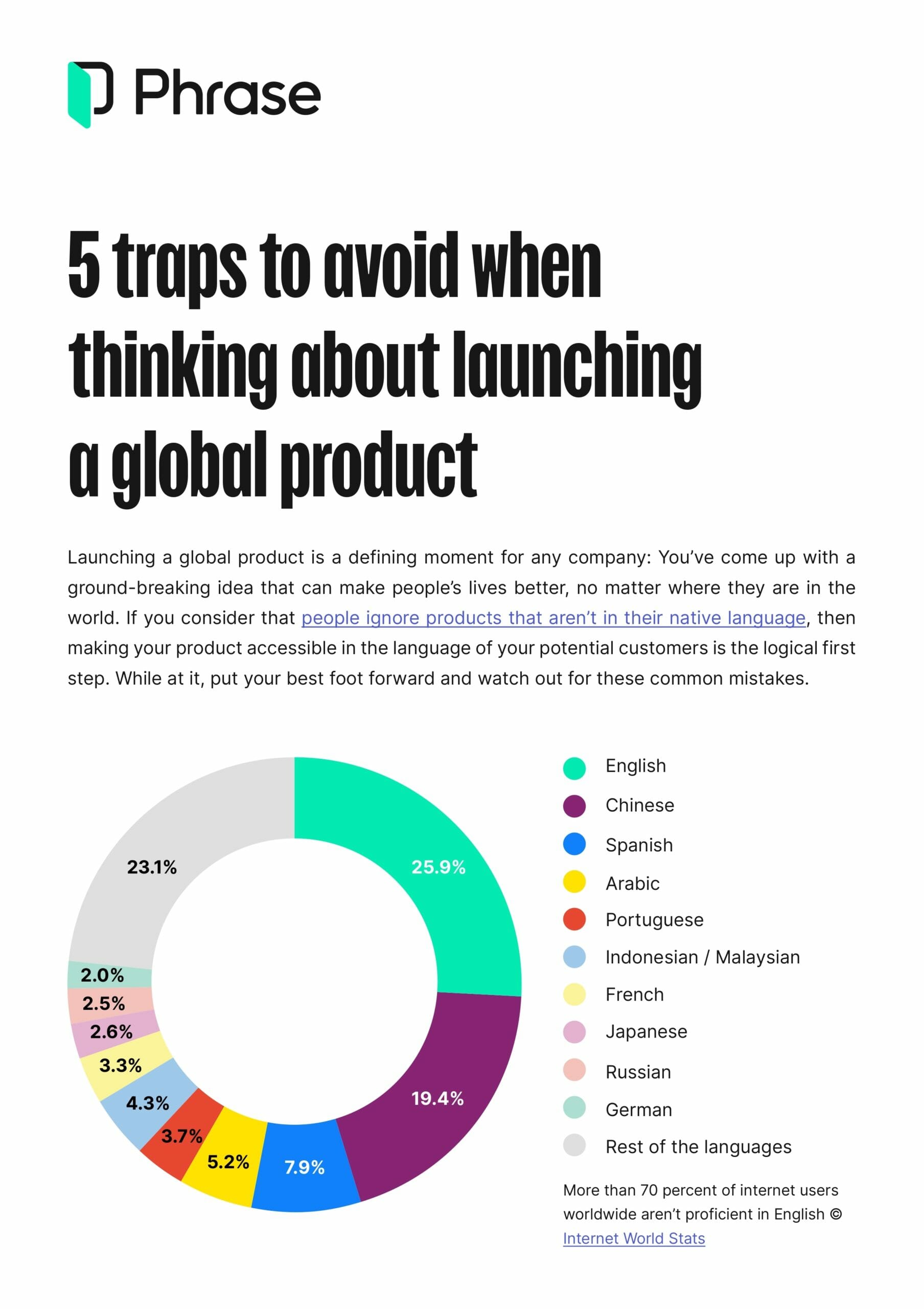
FREE DOWNLOAD
5 traps to avoid when thinking about launching a global product
Most people ignore products in languages that they don’t speak, so give yourself the best chance of success by avoiding these 5 common mistakes in global expansion.
Download guide
Why is market positioning important?
Without effective market positioning, you run the risk of leaving your brand and product reputation to chance. At best, consumer beliefs and images of your offerings may fail to reflect your goals. At worst, harm to your brand impacts your profitability. That’s why it’s essential to get market positioning right the first time. Let’s have a look at some of its core benefits.
- Market positioning allows businesses to establish a unique identity in the market: When you differentiate yourself from competitors, you can attract customers who seek specific benefits or solutions.
- It also impacts consumer perceptions and purchasing decisions: When a product is positioned effectively, your customers are more likely to perceive it as superior and willingly pay more.
- Finally, market positioning helps businesses build long-term customer loyalty: By consistently delivering on their promises, companies can develop a strong brand reputation and create a loyal customer base.
Types of market positioning
You have many positioning choices available to you depending on the nature of your product or brand. Each type of market positioning strategy caters to different customer needs and competitive landscapes. The key types of market positioning include:
- Product attributes positioning: This positioning type focuses on specific product attributes that differentiate it from competitors. For example, a smartphone company may position its product as having superior camera quality compared to other brands.
- Price positioning: Price positioning involves positioning a product as being affordable or targeting a specific price range. Companies may position their products as high-end and premium priced or as value-for-money options.
- Quality positioning: Quality positioning emphasizes the superior quality of a product compared to competitors. Companies may highlight factors such as durability, reliability, or exceptional craftsmanship to justify a higher price point.
- Usage positioning: This type of positioning focuses on the specific use or application of a product. For example, a laundry detergent may position itself as the best choice for removing tough stains.
- Competitor positioning: Competitor positioning involves directly comparing a product to competitors. This type of positioning is commonly used when a product offers clear advantages over competitors in terms of features, performance, or pricing.
Successful market positioning examples
To illustrate the concept of market positioning, let’s explore some real-life examples of successful marketing positioning:
- Apple: Apple has positioned itself as a brand synonymous with innovation, high quality, and user-friendly design (“Think Different”). Its products are known for their sleek aesthetics, intuitive interface, and seamless integration across devices.
- Volvo: Volvo has positioned itself as a brand synonymous with safety (“For Life”). Its vehicles are known for their advanced safety features and commitment to protecting drivers and passengers.
- Nike: Nike has positioned itself as a sports and fitness brand that inspires customers to push their limits and achieve greatness (“Just Do It”), emphasizing empowerment and motivation in its marketing campaigns.
- Airbnb: Airbnb’s market positioning (“Belong Anywhere”) revolves around providing unique travel experiences by offering accommodations that allow travelers to feel like locals and truly immerse themselves in the destinations they visit.
- Coca-Cola: Coca-Cola has positioned itself as the classic, timeless cola beverage, with its latest tagline (“Taste the Feeling”) highlighting the emotional connection that consumers have with Coca-Cola’s refreshing taste.
What is a market positioning strategy?
A market positioning strategy refers to the overall approach a business takes to position its product or brand in a target market. An effective market positioning strategy clearly defines the 4 Ps: product, price, place, and promotion.
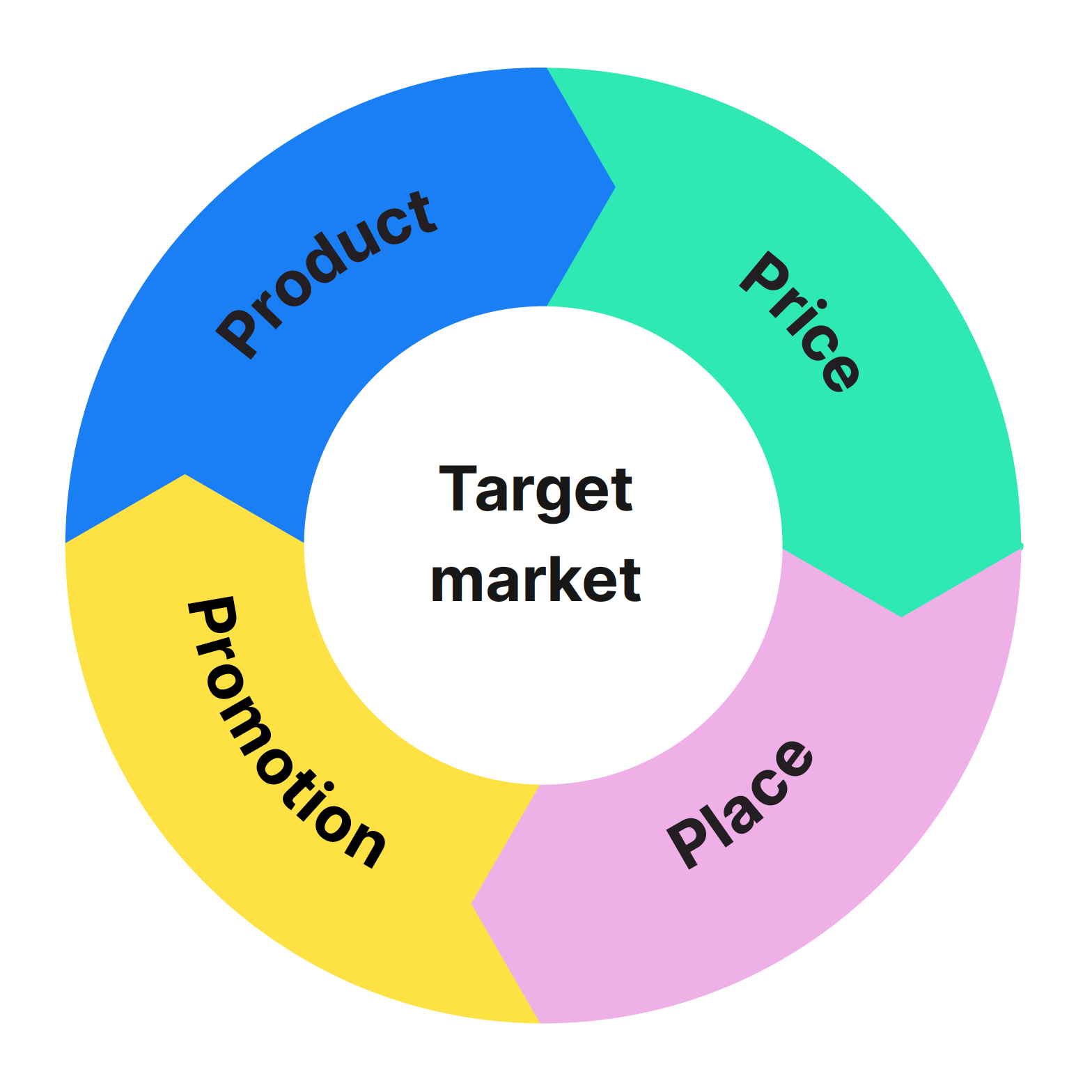
With a market positioning strategy, you ensure that you understand customer needs and have both a unique selling point (USP) and a unique value proposition (UVP). It will also guide all promotion efforts and shapes how a company communicates with its target audiences. By consistently delivering the message and reinforcing the desired image, your business can build brand awareness and loyalty among consumers.
How to develop a market positioning strategy
Developing an effective positioning strategy requires careful planning and consideration for companies to create a strong market presence and gain a competitive edge.
By understanding the target audience, identifying the USP, analyzing the competition, and effectively communicating the desired image, companies can create a strong market presence and gain a competitive edge.
Here are some essential steps to creating a market positioning strategy:
- Conduct market research : Start by understanding your target market and its needs. Conduct extensive research to gain insights into customer preferences, competitor offerings, and market trends.
- Define your target market segment: Clearly define the specific market segment you aim to target. Consider factors such as demographics, psychographics, and purchasing behavior to create a detailed customer profile.
- Identify unique selling points: Determine what sets your product or brand apart from competitors. Identify the unique features or solutions that resonate with your target audience.
- Define a unique value proposition: Craft a clear statement that communicates the exclusive benefits and value your product offers, setting it apart from the competition.
- Create a consistent brand image: Ensure that all marketing efforts align with the desired positioning strategy. From brand messaging and visual identity to customer interactions, consistency is key in establishing a strong market presence.
That being said, market positioning is an ongoing process that requires continuous monitoring and adaptation. As consumer preferences and market dynamics change, you need to stay agile and adjust your positioning strategy accordingly. This may involve reevaluating the target audience, refining the USP, or even repositioning the brand entirely.
Measuring the impact of your market positioning strategy
Measuring the impact of market positioning is essential to evaluate the effectiveness of your strategy and make necessary adjustments. While the specific metrics may vary depending on the nature of your business, there here are some key indicators to consider.
Market positioning is the key to global success
Market positioning is an integral component of any global expansion strategy. By effectively positioning your product or brand in different target markets, you can differentiate yourself from competitors, grow your customer base, and build long-term loyalty.
Whether through product attributes, price, quality, usage, or competitor comparison, positioning strategies play a crucial role in shaping customer perceptions and influencing purchasing decisions.
Finally, continuously evaluating the impact of your positioning strategy and making adjustments as needed can help you stay ahead in a competitive market.
Stay one step ahead

Choosing the Right AI Tools to Power Your Global Business Expansion

Machine translation
Machine Translation Software: Top 5 Tools to Try (and Use) in 2025

How AI Can Supercharge Your International Expansion Strategy
Keep exploring.

Optimizing Global User Experiences: Top Localization Strategies from ASICS, Workday, Uber, and Phrase

How to Create an Effective Market Positioning Strategy
Aug 28, 2024
12 min. read
Your market positioning strategy is a key piece when it comes to brand development. It helps guide content marketing plans, influencer marketing tactics, pricing and distribution models, and can even have an impact on decisions made outside of the marketing department.
But the concept of marketing positioning can be a little ambiguous. So in this post, we’ll delve into all you need to know about marketing and product positioning.
Table of Contents
What is market positioning, how to kick start your market positioning strategy.
Examples of Marketing Positioning Signals
3 Ways to Measure Market Positioning
Branding and digital marketing expert, Phil Kotler (also known as the "father of modern marketing”), defines market positioning as “the act of designing the company’s offering and image to occupy a distinctive place in the mind of the target market” .
In general, strategic positioning is used to influence the perception of a company or product in relation to others in the market. The idea is to create an image and brand identity that audiences recognize and relate to in a positive way.
See also: what is brand recognition , and the secrets behind excellent product branding
Perception is complicated. It varies from person to person and it’s fragile — it can take years to craft and seconds to shatter.
So, if it’s so temperamental, why do professionals invest millions into strategic market positioning? Well, there are a number of advantages that outweigh the risks, including:
- Better brand awareness
- Differentiation from competitors
- Charging premium pricing
- Increased recall
- Improved market and customer-centricity
- Easier to bounce back from crises
- Increased brand equity
With advantages like these, it’s clear why so many teams strive to have a well-laid out brand positioning strategy. Read on for how you too can reap these kinds of rewards.
To get started on a market positioning strategy, you need to asses the market as a whole, learn and track how your competitors are doing, and understand your goals. Here are some simple steps you should follow:
Conduct a competitive analysis
Plot a market map
Write a positioning statement
In order to create a unique positioning in marketing, you first need to understand how you compare to other companies in your space. This can be achieved through performing a competitive analysis using competitive intelligence .
Questions to ask:
- Who are your main competitors?
- How much influence do they have on each other?
- What key themes are associated with each competitor?
- Are certain competitors thought of more favorably?
- What do consumers like and dislike about them?
- Where are they performing the strongest?
- Where are they falling flat?
- How is the industry landscape performing as a whole?
- Where do the opportunities lie?
- Any threats or disrupters to keep an eye on?
- How does your organization compare and contrast amongst others in your category?
Once you have the answers to the above questions, your competitive positioning will become clearer.
Additional resources: How to Perform a Competitive Analysis , Competitor Benchmarking: What It Is and Why It Is Important
Plot a market map
Next, using the insights gathered from your competitive analysis, create a map of the market that shows your competitive positioning. A perceptual map, sometimes referred to as a position map or market map, is a v isual representation of how competitors are positioned in relation to your organization .
Through market mapping, you can better understand the thoughts and behaviors of consumers, spot industry trends, and identify gaps in your category, helping you craft a unique and differentiated identity.
Market maps takes the form of a matrix, representing two or more attributes that are rated on a scale. It's typically to compare a qualitative vs. qualitative attribute such as the following:
- Quality vs. price
- Functionality vs. price
- Performance vs. price
- Safety & reliability vs. price
Here are some examples to help you get started creating your your own map:
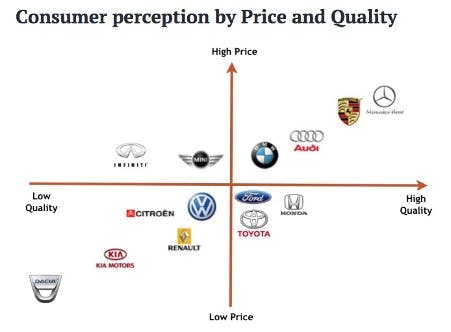
Never made this type of map before? We can recommend checking out GroupMap’s free tool and reviewing this article offering tips on plotting and reading market maps.
By now you should have a good idea of how you want to be perceived. The next step is to formalize these ideas into a written statement.
As explained by Hubspot , a positioning statement is a brief description of a product or service, the target market, and how the product or service fills a particular need of the target market .
It's an internal tool designed to focus and align efforts with your brand, mission statement, and value proposition.
Positioning statement examples:
G2 : G2 provides a B2B review site for business professionals who are looking to quickly discover, buy, and manage the best technology for their needs. Unlike other B2B review sites, G2 offers 700K+ unbiased and verified user reviews in over 1400 categories.
HubSpot : Since 2006, HubSpot has been on a mission to make the world more inbound. Today, over 68,800 total customers in more than 100 countries use HubSpot’s award-winning software, services, and support to transform the way they attract, engage, and delight customers. Comprised of Marketing Hub, Sales Hub, Service Hub, and a powerful free CRM, HubSpot gives companies the tools they need to Grow Better.
Tips for writing a positioning statement:
- Keep it short and sweet
- Make it unique
- Stay aligned with your core values
- Include your promise
- Explain why your company is different
Follow the below positioning statement example formula as a rule of thumb:
For [your customer], [your company] is the [your market] that best delivers on [your promise] because [your company] is [your evidence].
Examples of Market Positioning Signals
Now you that you understand your positioning and have summarized it into a statement, it’s time to think about what marketing positioning strategies you’ll use.
Companies that generate strong, positive, connections in consumers minds didn’t happen by chance. A team of marketing experts carefully crafted that perception through a number of signals (or strategic positioning strategies).
Let’s explore some of those signals in more detail:

Perceived quality
Corporate endorsements, influencer marketing, thought leadership, distribution.
More often than not, price is a key factor in a customers decision-making process. Because of this, marketing teams use their pricing strategy to portray a distinct image and, hopefully, influence how prospective customers perceive the value being presented.
Pricing strategy can revolve around keeping prices as low as possible, or it can be more complex. Offering "premium" prices, or pricing higher than the competition can trigger a sense in consumers mind that the higher priced items are better quality, or more worth the cost.
Price and perceived quality often go hand in hand, which is why they’re frequently used attributes for perception maps. According to David Aaker, consultant and professor, perceived quality has three prongs: 1. Objective quality : based on the performance of a product 2. Manufacturing quality : based on how well made a product is (or isn't) 3. Product-based quality : associated with features, parts, ingredients, or services Say you have two TVs, one is a 4K plasma Smart TV with after sales care, and the other is a standard model with no bells and whistles.
You may think that the entry-level TV would naturally be perceived as being lower quality as it has fewer features. But strategic marketing positioning requires you to understand what "quality" means to different customer segments.
If certain audiences prefer to look at the manufacturing specs materials used and the entry-level TV comes out top, consumers will deem that to be of better quality regardless of the product attributes of the plasma TV. Moreover, the plasma TV may be produced by a company that has a history with product recalls, in which case, consumers are likely to think that entry-level TV is still better quality.
So to summarize, it's important to achieve perceived quality on a level that consumers consider important. Want to learn more about better understanding your target audience and their decision making process? Check out our Meltwater Audience and Consumer Insights tool or take a look at the best consumer insights tools in comparison !
Another positioning signal often leveraged by marketing and branding teams is corporate endorsements.
While McDonald's is known as being a fast-food company, they worked to dispel their unhealthy image through their London 2012 Olympic sponsorship .
Despite the sponsorship confusing people at first, it gave McDonald's the publicity and platform they wanted to raise awareness around obesity. In line with their sponsorship, they unveiled a large-scale promotional push which took place throughout the duration of The Games and included activity toys with Happy Meals and vouchers for sport sessions.
As a top-tier International Olympic Committee sponsor, McDonald's was also the only branded food in the Olympic Park and the Athlete's Village. The messaging strategy? If a Big Mac is good enough for the world’s top athlete’s, it's good enough for you (in moderation… of course)!

Influencer marketing can also significantly help company positioning efforts. Due to consumers often finding influencers more credible than owned brand content, it’s a great strategy to use for those wanting to amplify positive brand perceived amongst their target audience.
With that being said, choosing the right influencers to endorse your brand is critical. Make the wrong decision and your business can end up being positioned in a totally different direction than what you set out to achieve.
Thankfully you don’t have to rely on your intuition alone when choosing influencers. Using an influencer management solution , you can filter by specific attributes and topics to find the perfect influencer partners.
Tip: These are the best social influencer management platforms and social influencer marketing platforms .
Lots of companies choose to include thought leadership in their content marketing strategy and frame their executives as experts on certain topics . Thought leadership is useful for all organizations, but it’s especially helpful for those wanting to break into a new category, as it can make your leadership seem more credible and trustworthy.
A great example is Lush cosmetics . To strengthen their positioning as a company focused on cruelty-free products, Lush stays closely involved in lobbying for animal rights. They even have their own award, The Lush Prize , which is the largest prize fund in the non-animal testing sector, awarding £250,000 to support initiatives that work to end or replace animal testing.

Your distribution strategy can say a lot about you, and is a big factor in market positioning. For example, if you're a luxury brand, you may want to opt against selling your goods in convenience stores, given that the products sold in convenience stores tend to be lower in price in order to match the consumers browsing mindset and expectation.
That said, while it’s unlikely that customers will stop in to get a pint of milk or loaf of bread and walk out with a £1,000 handbag — but if it’s lower-priced, you might just trigger that impulse buy! It all depends on the goals and capacity of your distribution strategy.
It's important to note that when selling goods through retailers, brands have less control over promotional efforts. This is why it’s rare to see extremely exclusive brands in department stores — yes, even the fancy ones! Such companies prefer owning their owns stores, and in most cases, rarely offer promotions — a strategic tactic that helps strengthen their exclusive market positioning!
There’s no use putting all this effort into strategic positioning if you’re not going to measure whether or not your choices have been successful in moving the needle. As mentioned earlier, perception is complicated — but that doesn’t mean it can’t be analyzed.
Below you’ll find 3 strategies you can use to understand if you’ve influenced how your target audience perceives you.
Media monitoring
Use media intelligence and social listening insights to see how your thought-leadership content is resonating, and follow product mentions to assess if your pricing and distribution choices are making sense.
You can do this by measuring how many times your organization is mentioned alongside relevant industry conversations and keywords. You can even get a sense for how prominent your company is within the conversation, compared to your competitors.

Audience analysis
Use a consumer analysis tool to see if there's a strong correlation between communities who follow you on social media, or if there’s a disconnect. If there's a disconnect, it doesn't have to be a bad thing! It may simply shine a light on a new marketing opportunity for your products.
This can be achieved by looking at dimensions such as audience affinity, how your target audience describes themselves in their bios, other types of companies they follow, and so on. This is especially useful if you want to measure whether you’ve successfully connected with the type of target audience you’re marketing to.

Hold a focus group
Brand salience is the degree to which your company is thought of or noticed by consumers when they make a purchase decision. Focus groups are a great way of qualitatively measuring brand salience .
Now you should have a better understanding of what market positioning means and how to get started on a market positioning strategy. To see how Meltwater can help with your strategic positioning, fill out the form below!
Continue Reading

What Is The Marketing Mix? 4Ps & 7Ps of Marketing

Why You Need a Marketing Communication Strategy

What Is Marketing & Why Your Business Can't Do Without It

Personalization at Scale: Removing Guesswork from Consumer Research

Why Branding & Brand Management Are a Must-Have for Your Business

What Is Brand Tracking? Brand Health Tracking Guide
The Complete Guide to Positioning in Marketing
Learn how to improve your positioning in marketing. We cover the benefits of positioning, types of positioning, examples, how to create a positioning strategy.
Manager of the Experts Success Team at Mayple
Learn about our
Natalie is a content writer and manager who is passionate about using her craft to empower others. She thrives on team dynamic, great coffee, and excellent content. One of these days, she might even get to her own content ideas.
Updated November 20, 2023.

There are probably hundreds or even thousands of companies that provide products or services similar to yours. They give similar promises and offer similar benefits, and thus they have a similar position in the mind of the average consumer.
Such a situation makes the consumer wonder why they should go for one company instead of another. They might feel like all the options are the same. As a business owner, your job is to show why your products are not the same as others’ products and why you can provide unique value to customers about your competitors.
The process of positioning is crucial for your marketing strategy and marketing efforts. This guide will help you learn how to distinguish yourself from your competition in the consumers’ minds, thus getting ahead of your competition in a highly competitive market.
What does positioning mean in marketing?
Positioning is one of the 4 P’s of the marketing mix and refers to the process influencing the consumer perception of your brand or a specific product you offer. More specifically, positioning is the process of creating a specific image of your brand with which your target customers will associate you, thus distinguishing you from your competitors.
As Ries & Trout say, “Positioning is not what you do to a product. Positioning is what you do to the mind of the prospect. That is, you position the product in the mind of the prospect.”
Positioning is all about choices - choosing your place in the market. For example, a car manufacturer may emphasize the practicality of its cars, positioning them as quality vehicles for the average consumer instead of costly status symbols. Likewise, a fast food chain may position itself as a palace to get inexpensive and quick meals, unlike high-end restaurants.
On the other hand, a fashion brand may position its clothes as high-end status symbols with completely unique design choices. This would make it stand apart from other clothing manufacturers.
No matter what business you run, positioning is invaluable for showing consumers why they should pick your brand out of all the others. You need to create a distinct image and make it stick in your consumers’ minds to have a lasting impact and ensure they don’t forget you and the value you bring.
Positioning is somewhat similar to processes such as branding, value proposition, messaging, and differentiation. However, there are some key differences that we need to highlight to understand better what positioning is.
Positioning vs. branding
Branding refers to creating a unique logo, tagline, or slogan to create an original brand image . You can think of the McDonald’s logo and the recognizable “I’m lovin’ it” slogan. These two elements are unique to the company and instantly recognizable.
Positioning is similar, but its main focus is on creating a specific image or idea of your brand in your customers’ minds. For example, you might try to position your company’s products as more practical when compared to your competitors.
Positioning vs. value proposition
Positioning can also be confused with a value proposition. A value proposition is a promise you make to your customers regarding the benefits, use, and quality of your products or services. So a value proposition might be a part of the positioning, but it is not the same process.
Positioning vs. messaging
While positioning involves outlining the uniqueness of your products and services in comparison to your competitors, messaging is when you communicate how you’ll fulfill your promises to your target audience.
Positioning vs. differentiation
Since positioning is to a great extent about how different your product is from the competition, it might be easy to confuse it with differentiation. However, differentiation is a tactic you use to make a specific offer or product stand out and get more interest from the target audience.
The benefits of positioning in marketing
Now that we know what positioning is, we should examine its benefits in greater detail. Here are all the benefits of having good positioning.
Have a stronger position in the market
When you create a positive image of your company in consumers’ minds and associate your business with a certain value, you’ll attract more customers.
A successful positioning campaign will cement your position not only in consumers’ minds but also in the target market. The goal is to have consumers believe that your products and services provide more value than those of your competitors.
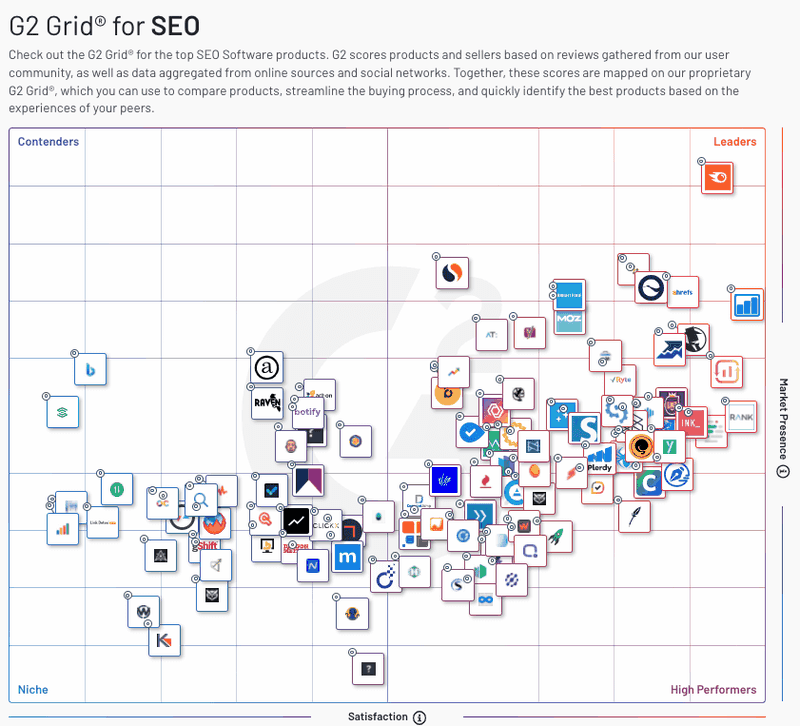
Increase sales
Improved positioning can lead to greater sales. Having a relevant offer and communicating information about your company effectively may allow you to get a bigger piece of your existing market and expand to new markets.
Better market to your target audience
Positioning also allows you to reach out to your target audience and better capture their imagination. This will allow you to market your products and services to your target buyers better. You will be able to address their needs and pain points effectively, thus turning them into more loyal customers.
Build a stronger brand
Positioning goes hand in hand with branding. While branding will give you a recognizable logo and slogan, positioning will ensure that your brand is associated with a certain value and that your (potential) customers see it in a certain way. And together they are part of an overall branding strategy .
You might position your business as one that provides convenience at a reasonable price. Such clear positioning will result in a strong brand because you’ll show that you have a clear focus and target demographic. Customers who prefer this kind of service or goods will know where to look for them.
Every brand must have a specific focus. A brand that tries to cater to everyone will end up catering to no one. And a great branding freelancer will be able to help you take your first-party data and create a brand that attracts your ideal customer.
Types of positioning in marketing
There are different types of positioning depending on what you want to focus on in your business. Let’s look at each one in detail.
For most consumers, a product’s price is a determining factor when they have to decide if they’ll buy something or not. A company that offers affordable products with reasonable quality will most likely have lots of success with customers if it positions itself as a low-cost brand with decent products.
A good example of this is Dollar Shave Club compared to Gillette. Even though Gillette was the leading company in the razor blade market, Dollar Shave Club took over a decent chunk of their market due to their unusually low prices and good quality.

The cheapest razor cartridge from Dollar Shave Club is only $0.20, which swayed many customers to their side. This enabled Dollar Shave Club to successfully take on a giant like Gillette. They have positioned their business around a competitive pricing strategy and it worked. They were acquired by Unilever in 2016 for a whopping $1 billion .
Quality is the determining factor for companies that sell products in the same price range. Think of the reason people buy Volvos - they are more expensive but are significantly better quality-wise than other cars. Consumers for whom product price is not an issue will want to get the highest possible quality.

Chipotle and Taco Bell are good examples of this. Chipotle was able to get a good part of the market share when it focused on quality instead of price.
Competitors
When positioning your brand, you must also emphasize the ways in which you’re better than your competition. This can refer to your superior customer service, top-notch experts that you hire, or better standards of production.
Convenience
Sometimes your biggest strength might be the convenience you offer to your customers. It can refer to the sheer number of your stores or office, accessibility, multiple-platform support, or ease of use of your application(s).
A convenience-based positioning strategy attracts busy customers, who are often willing to pay extra to save time. And while it can get you greater profits, it can also cost more. For example, if you’re offering a mobile app and a desktop version of the app, you can get more customers, but you’ll need to spend more on development.
Customer needs
If you want to get and retain customers, you must be ready to quickly and efficiently meet their needs. Consumers are generally happy to pay a premium price if they know that any problem they might have with the product will be solved quickly and efficiently.
On the other hand, If consumers perceive you as cold and disinterested, they’ll rather opt for someone else, even if your goods or services are top-notch.
Positioning your company around your customer and their needs is a powerful strategy that helps cement your position in the market.
Product use
Another thing you can focus on is the intended use of your product(s) and its characteristics. It’s impossible to create products that customers can use for everything and in every situation, so you have to focus on a particular characteristic and use it to stand out.
For example, Volvo emphasizes the safety of its vehicles, and drivers who prioritize that characteristic know where to turn when buying a car. On the other hand, drivers that prefer reliability will turn to Toyota, as the company positions itself as a manufacturer of reliable cars.
Examples of positioning in marketing
Now that you know the different types of positioning here are a few great examples from the world’s most famous brands. These examples will deepen your understanding of positioning and they might give you some useful ideas you can use in your marketing efforts.
1. Tinder and Bumble
Tinder and Bumble are two of the biggest names in the dating industry and they rely on different positioning strategies to attract new users and retain the ones that they have.
Tinder tries to position itself as a leader in the industry by drawing attention to its large number of users ( 75 million and counting) and its long presence in the market. That’s an important factor for potential users who would like to have a wide pool of potential dating partners.
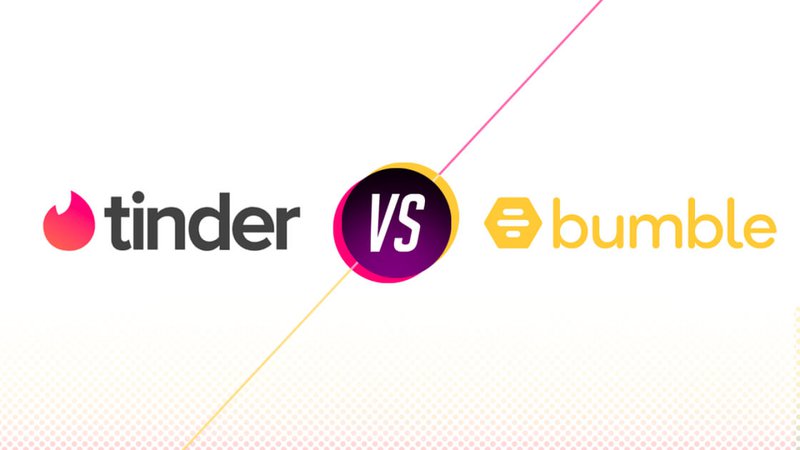
On the other hand, Bumble uses its unconventional approach to position itself as a game changer in the industry. Bumble is specific because it only lets women initiate conversations, and it also offers users to look for friendships and business connections.
Therefore, Bumble relies on differentiation to stand out from the competition and present itself as an innovative alternative to its competition.
2. Apple Music and Spotify
Apple Music and Spotify are bitter rivals when it comes to music streaming. Even though their services are similar, their positioning strategies are quite different.
Spotify relies on a price-based strategy. While it has a premium option that makes it very similar to Apple Music, it also offers a free plan that attracts many users. Additionally, it offers a great degree of personalization that allows users to enjoy their favorite music and discover new artists with only a few clicks.
Apple Music focuses on its status as a prestigious service. It emphasizes its impressive catalog of 60 million songs and exclusive features such as on-screen lyrics and music videos, which Spotify offers for only a few songs.
3. Walmart and Target
The rivalry between Target and Walmart can also give us a great example of different positioning strategies. While both chains offer similar products and prices, their positioning is vastly different.
Walmart competes on price and offers the best-priced goods in the market. This has some drawbacks and it has earned them an interesting reputation but customers know that if they want to get the best deals they should go to Walmart.
On the other hand, Target focuses more on customer experience and product quality. Target stores tend to be better organized, and the customers find the experience much more enjoyable than the one they might get at Walmart.
4. Popeyes vs. Chick-Fil-A
Both companies serve tasty fried chicken but with very different approaches. Popeyes focuses on differentiation, while Chick-Fil-A focuses on its quality and customer service.
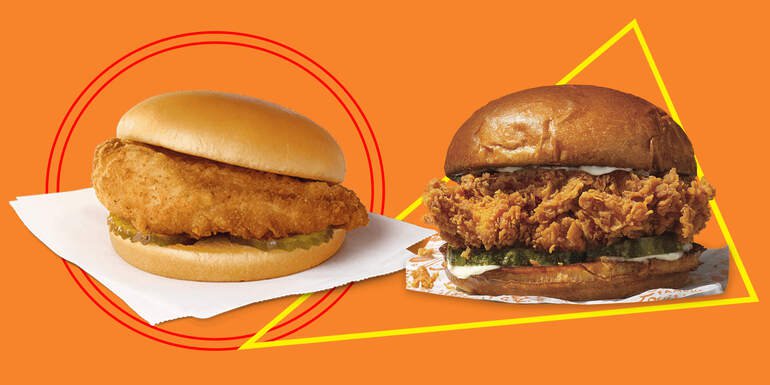
Popeyes’ main focus is on home style, Cajun recipes, and food that are different from many other similar chains. This allows them to stand out from the crowd and be recognizable for their food.
Chick-Fil-A emphasizes the quality and general appeal of its food to position itself. However, their strategy is hybrid because they also rely on customer service . They don’t brag about it, but they let their employees’ actions speak for themselves, so they’re recognized as a place where customers feel well-treated.
How to create an effective positioning strategy
Here is a step-by-step process for creating an effective market positioning strategy for your business.
1. Define your current position
Before you dive deep into the positioning process, you must first determine your current position in the market. Do prospective customers see your products as just another thing on the market, or do they see them as something unique? Conduct some research to determine how your products are perceived by your target audience.
After that, you must determine who your potential and ideal customers are and how you can connect to the typical buyer persona. If you have a wide range of products, segmenting your customers is also a good idea. This will help you create campaigns that cater to specific market segments.
2. Analyze your competitors
Competitor analysis is just as important as analyzing your own position in the target market. Conduct a SWOT analysis to see how you stack up against your competitors. Identify the weaknesses you need to address, as well as the strengths you should emphasize.
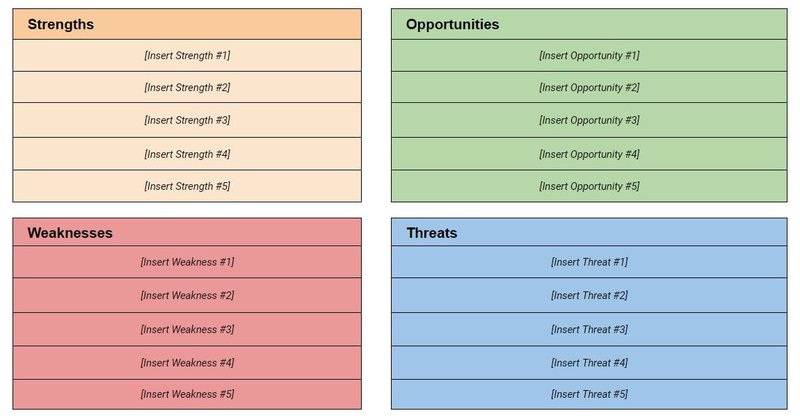
Pro tip : take note of your competitors' marketing channels, tactics, and advertising campaigns, and record all of those in your marketing plan . Refer back when you need fresh ideas of what works in your target market.
3. Create a positioning map
Positioning maps are a visual representation of how you compare to your competition based on certain attributes and values they find important. It’s a super helpful tool that helps you see a clear picture of the strengths and weaknesses you and your competitors have.
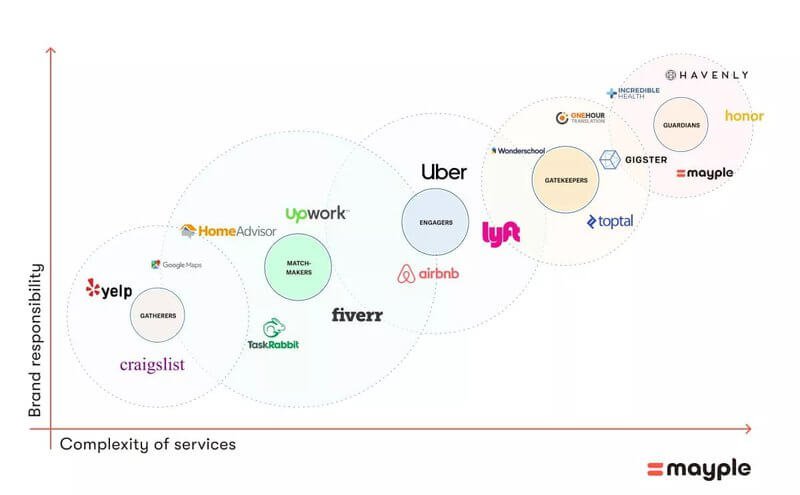
4. Tweak your current position
Once you know what you need to work on, you can start tweaking your position. Emphasize your strengths compared to your competitors and convince your potential customers that your business is the place to go if they’re looking for a certain value.
This value should be the one you’ve identified as your strong point and decided to push forward as a factor that differentiates you from the competition. This should also be the value you associate with your customers’ needs.
5. Create a positioning statement
Your positioning statement should be one or two sentences long and briefly state your mission and goals. It should emphasize your uniqueness compared to your competition.
It consists of three elements - what you do, who your target audience is, and the greatest benefit that your product provides.
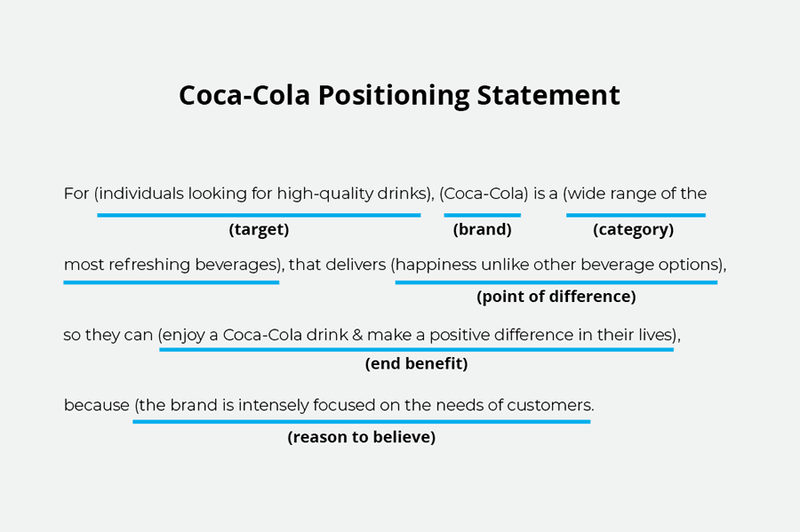
For example, here’s a compelling positioning statement from Amazon: “Our vision is to be the Earth’s most customer-centric company, to build a place where people can come to find and discover anything they might want to buy online.”
This statement summarizes their goals and proof of the statement has become self-evident. Amazon offers basically anything you might want to buy, it’s all available at the click of the mouse, and it's delivered to your doorstep.
6. Create a tagline
A tagline is better known as a slogan. A good slogan can be almost synonymous with your brand and will do an excellent job showing your customers what they can expect from your company.
We’re all aware of slogans such as “Just do it” from Nike or “Because you’re worth it” from L’Oreal. Those slogans are instantly recognizable and tell consumers exactly what they can expect from the companies.

7. Test your marketing positioning
Once you’ve prepared everything essential for positioning, it’s time to put it to the test. It takes time until your customers’ perception of your business changes into what you want it to be. This allows you to track the progress of your positioning campaign and make changes.
Don’t expect your positioning campaign to be effective immediately. It’s almost impossible to do everything perfectly right away, so embrace the effort and know that it’s a process.
Looking to position your company?
If you’re serious about standing out and conquering your competition, you need to have a successful positioning strategy.
It could seem daunting but you don’t have to do it alone. Hire the perfect marketing consultant through Mayple and get the job done. Get started now and start working on a killer positioning plan!
What is the meaning of market positioning?
Market positioning refers to shaping the consumer perception of your brand, company, or products. Brands position themselves by creating an image or identity of the brand or product so that consumers view it in a certain way. It’s an important part of your marketing mix and serves to strengthen your brand and improve sales.
What is the importance of market positioning?
The objective of market positioning is to stand out from the competitors and show your uniqueness to the customers. It associates your company with certain values and characteristics, and people will know they should turn to you if they’re looking for those values and characteristics.
It's important for companies that want to develop better messaging for their target segment, improve their current market position, and increase sales.
What is meant by positioning in marketing?
Positioning is how consumers see your brand. In other words, it refers to the values you want your customer base to associate you with. It can also refer to how consumers see your product in relation to other products on the market. Good positioning makes your product unique in the eyes of your target segment and helps display the benefit it provides for them.
What are the 5 positioning strategies?
The five positioning strategies are: quality positioning, convenience positioning, customer needs positioning, product positioning, and competitive positioning.
What are the 4 types of product positioning?
There are four types of product positioning: price-based positioning, lifestyle-based positioning, characteristics-based positioning, and quality-based positioning. You can also use a combination of two types of product positioning together to make your product stand out in the market.
What is an example of positioning?
Volvo is a good example of positioning in the car industry. The company emphasizes the safety of its vehicles, so consumers who prioritize that characteristic know that Volvo is the best option for them.
Why is positioning important?
Positioning helps you boost sales, attract your target audience, and create a unique image of your company. This makes you a recognizable force in the target market and cements your position in your customers’ minds.
What are the 4 Cs of positioning?
The four Cs of positioning are clarity, consistency, competitiveness, and credibility. They tell what your main focus should be when working on your positioning. They were created by David Jobber and John Fahy in their book "Foundations of Marketing" (2009).
Related Articles

Ben Kazinik
How Do You Build Backlinks?

Jacob Elbaum
When to Start Conversion Rate Optimization?

Omer Farkash
Top 10 Marketing Management Skills Your Business Needs in 2024

Rakefet Yacoby From
Next generation service marketplaces take trust to a new level

Octavia Drexler
Top 19 PPC Platforms You Should Consider in 2024

IMAGES
VIDEO
COMMENTS
The purpose of a positioning statement is to convey a brand's value propositionto its ideal customers. It also frames the brand's identity, goals, and distinguishing features within the context of the b…
Market positioning, in simple words, is a marketing strategy that focuses on creating a unique image or perception of a brand, product, or service in the customer’s mind. A business can create that unique image by any means.
The goal of a positioning strategy is to influence consumer perception by effectively communicating a brand’s competitive advantage. The concept of positioning rose in …
Unlock the secrets to effective positioning strategy with our comprehensive guide. Learn how to differentiate your brand, attract your target audience, and gain a competitive …
What is a market positioning strategy? A market positioning strategy refers to the overall approach a business takes to position its product or brand in a target market. An effective market positioning strategy clearly …
Your market positioning strategy is a key piece when it comes to brand development. It helps guide content marketing plans, influencer marketing tactics, pricing and distribution models, and can even have an …
Learn how to improve your positioning in marketing. We cover the benefits of positioning, types of positioning, examples, how to create a positioning strategy.